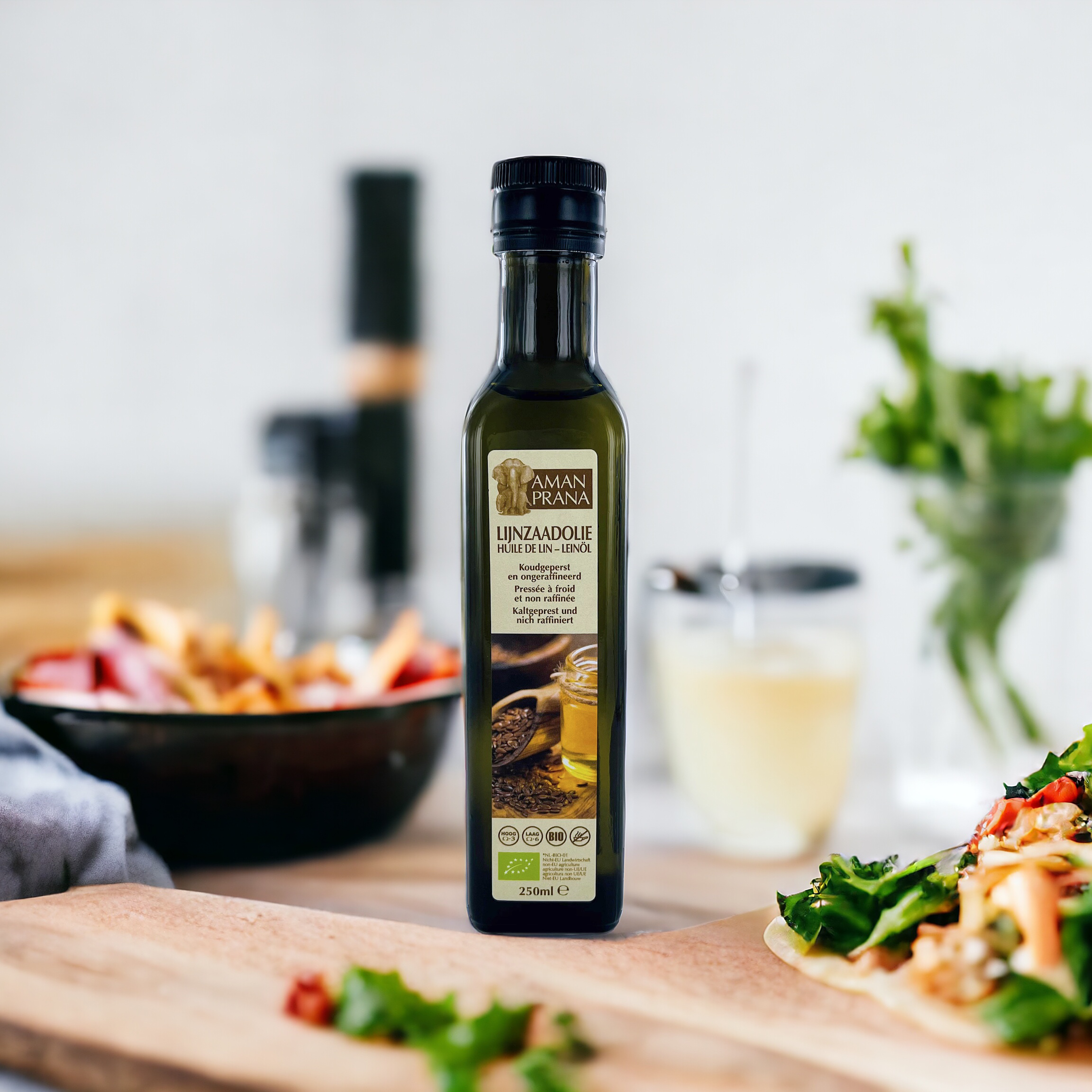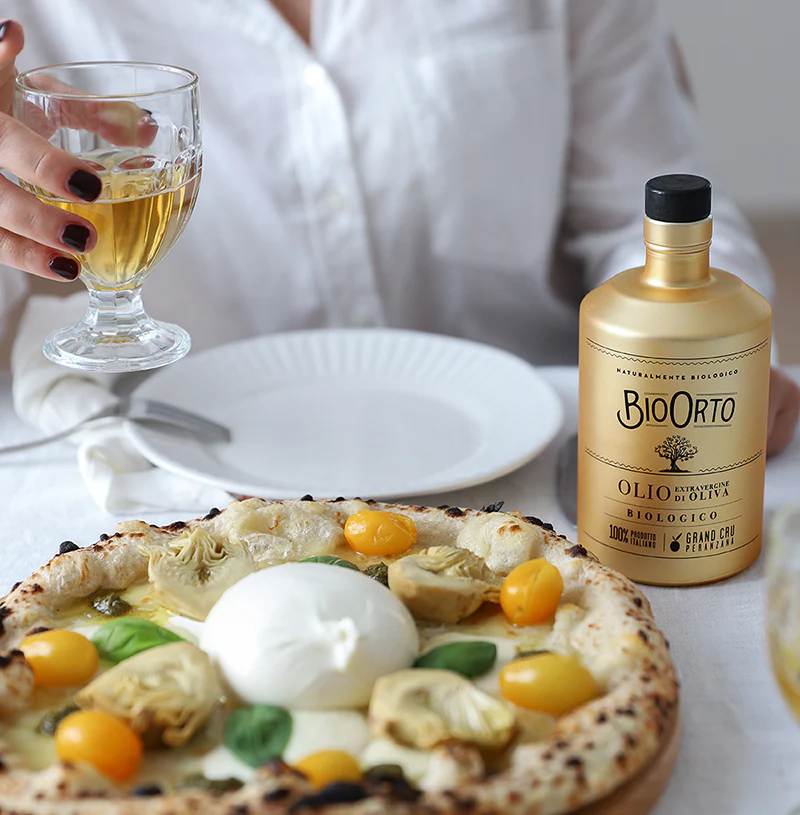Imagine sitting in a café on the Mediterranean, the sun is setting, and in front of you is a dish drizzled with the golden nectar of olive oil. Sounds dreamy, doesn't it? But did you know you don't have to travel to the Mediterranean to experience it? With the right olive oil, you can bring that authentic Mediterranean atmosphere right into your kitchen!
In this blog post, we'll go over the following:
- Understanding the terminology associated with olive oils.
- Understanding the variety of flavors of different olive oils
- Where olive oils come from
- What types of olives there are
- Why flavorful olive oils can be a fantastic way to enhance your dishes
- Conclusion
Section 1: Understanding Olive Oil Terminology
Extra Virgin
Extra virgin olive oil, or EVOO, is the highest quality of olive oil available. It’s made from pure, cold-pressed olives, which means no heat or chemicals were used during extraction. This results in oil that has an acidity level of less than 0.8% and superior taste. For example, our Mueloliva Extra Virgin Olive Oil is a delightful Spanish olive oil with a balanced and robust flavor profile.
Cold Pressed
Cold-pressed oils, like our Amanprana Extra Virgin Olive Oil Premium, are extracted at temperatures below 27 degrees Celsius. This process preserves the antioxidants and monounsaturated fats, and results in a high-quality, flavourful oil.
Organic
Organic olive oil is made from olives grown without the use of synthetic pesticides and fertilizers. It's a healthier choice that respects the environment. Our Bio Orto Basil Oil is a wonderful example, sourced from Italian olives grown in harmony with nature and infused with fresh authentic basil.
Polyphenols
Polyphenols are antioxidants present in olive oil that contribute to its taste and health benefits. The Mani Olive Oil Extra Virgin with Polyphenol is packed with these mighty molecules, known for their anti-inflammatory and heart-health benefits.
Unfiltered Olive Oil
Unfiltered olive oil, as the name suggests, has not been filtered after the extraction process. This can result in a slightly cloudy appearance due to tiny particles of olive pulp or sediment suspended in the oil. Some people believe unfiltered oil has a richer flavor due to these particles. However, because it can spoil faster, it should be consumed relatively quickly.
Virgin Olive Oil
Virgin olive oil is a grade below extra virgin. It's made using the same process as EVOO (cold-pressed and without chemicals), but it has a slightly higher acidity level — between 1% and 2%. It may also have minor defects in flavor or aroma. Despite this, it's still a high-quality oil, just with a less pronounced flavor than EVOO.
Pure Olive Oil
Pure olive oil, sometimes just labeled as "olive oil", is a blend of cold-pressed and processed oils. The processing method involves heat and/or chemicals to extract the oil, which can reduce the oil's natural flavors, aroma, and nutrients. This type of oil is more economical and has a milder flavor, making it suitable for cooking where a strong olive taste is not desired.
Licht and Extra Light Olive Oil
Light or extra light olive oil doesn't refer to the oil's calorie content, but rather its color and flavor. This oil is often a blend of cold-pressed and processed oils, like pure olive oil, but it has undergone a more thorough refining process that gives it a lighter color and milder flavor. Despite the name, it still has as many calories as other types of olive oil.
Pomace Olive Oil
Pomace olive oil is the lowest grade of olive oil. After the higher quality oils have been extracted from the olive pulp, heat and solvents are used to extract the remaining oil from the pomace, or pulp left over from the first extraction. Pomace oil is often used for frying or other high heat cooking, but it lacks the flavor and health benefits of higher grade oils.
PDO and PGI quality labels.
PDO (Protected Designation of Origin) and PGI (Protected Geographical Indication) are European Union designations that guarantee an olive oil's origin. A PDO label means that all stages of production occur in a specific region, while a PGI label means that at least one stage of production occurs in the region. These labels often indicate a higher quality oil, as the olives are grown in areas with ideal climates and soil conditions for olive cultivation.
Harvest Date
The harvest date on a bottle of olive oil can tell you a lot about its freshness. Unlike wine, olive oil does not improve with age. On the contrary, its quality starts to decline as soon as it's extracted from the olives. Most olive oils are at their best within 18 to 24 months of their harvest date. Checking the harvest date can therefore give you an idea of the oil's freshness.
Section 2: Tasting olive oil - It's all about the taste
The flavour of an olive oil can be influenced by many factors, including the type of olive, soil, climate, and extraction process. Olive oils can be classified into three categories: mild, medium, and robust.
- Mild olive oils, such as the Amanprana Extra Virgin Olive Oil Premium, have a lighter taste that's often buttery and slightly sweet. They're ideal for baking and sautéing.
- Medium olive oils, like our Bio Orto Grand Cru Olive Oil Extra Virgin Peranzana, have a more balanced flavour. They're great for roasting and grilling.
- Robust olive oils, such as the Hermanos Catalan Extra Virgin, offer a strong, peppery finish. They're perfect for hearty dishes and bold salad dressings.
Do an Olive Oil Flavour Tasting
If you've only used olive oil for sautéing vegetables or as a salad dressing base, you're in for a treat. Olive oil tasting is an experience unto itself. Here's how to savor the nuances of each bottle:
Pour & Observe
Pour a tablespoon of olive oil into a glass. Notice the oil's color. Keep in mind that color does not necessarily denote quality or flavor - but it's part of the experience!
For instance, the Amanprana Extra Virgin Olive Oil Premium has a beautiful green-gold hue, while the Bio Orto Grand Cru Extra Virgin Olive Oil Coratina shows off a deeper, more intense golden color.
Swirl & Smell
Cover the glass with one hand and swirl the oil to release its aroma. Bring your nose close to the glass and take a deep inhale. The scent could range from fruity to grassy, to more earthy undertones. The Bio Orto Grand Cru Olive Oil Extra Virgin Ogliarola, for example, has a distinct fresh and grassy aroma.
Sip & Slurp
Now for the tasting! Sip a small amount of oil while "sucking in" or slurping air as well. This technique, much like wine tasting, helps to spread the oil throughout your mouth, revealing its full flavor. Try to identify the different flavor notes - is it grassy, peppery, or perhaps even slightly bitter.
Swallow and Savour
Finally, swallow the oil and notice any peppery or burning sensation in your throat. A slight peppery kick is a good sign - it means that the oil is high in health-boosting polyphenols.
Section 3: The Origin of Olive Oil - Exploring the Mediterranean
Italian Olive Oil
Italy is known for its long-standing olive oil heritage. Italian oils, like the Bio Orto Grand Cru Olive Oil, are renowned for their complexity and the robust, fruity flavors that reflect the country's diverse climatic conditions and olive varieties. The Coratina olive, used in the Bio Orto Grand Cru, is known for its high polyphenol content, which lends the oil a slightly spicy taste and high antioxidant levels.
Regions like Tuscany and Umbria produce oils that are often green and peppery, while oils from southern Italy, including Puglia and Sicily, tend to be golden and fruitier. Whether drizzled over bruschetta, mixed into a pasta sauce, or used in a dressing for a Caprese salad, Italian olive oils add a dash of Mediterranean sunshine to any dish.
Spanish Olive Oil
Spain is the world's largest producer of olive oil, known for its high-quality oils that are golden in color, with balanced, fruity flavors. Our Cortijo de Suerte Alta Picual Extra Virgin Olive Oil is an excellent example of a Spanish olive oil. This oil, from the Andalusia region, is made from Picual olives which give it a robust taste with a touch of bitterness and spiciness.
Andalusian oils like these are a kitchen staple for their versatility – they pair well with everything from gazpacho and paella to roasted vegetables and meats.
Greek Olive Oil
Greek olive oils, like the Mani Olive Oil Extra Virgin with Polyphenol, are often robust, peppery, with a slightly bitter finish – a nod to the Koroneiki olive variety that is widely grown in the country. These oils are high in polyphenols, beneficial antioxidants linked to heart health.
Greek olive oils are often used in traditional dishes like Greek salad, tzatziki, and moussaka, but their robust flavour also stands up well to grilled seafood and roasted meats.
Croatian Olive Oil
Croatia, though a smaller producer, has been gaining recognition for its high-quality olive oils. Croatian oils often have a fresh, grassy aroma, with a peppery aftertaste that reflects the indigenous olive varieties like Oblica and Lastovka. Croatian olive oils are ideal for seafood dishes, reflecting the country's extensive coastline.
Israeli Olive Oil
Israeli olive oils reflect the country's rich, ancient tradition of olive oil production. Many Israeli olive oils, like those made from the Souri or Nabali olive varieties, have a green, fruity profile with hints of artichoke and herbaceous undertones. These oils complement traditional Israeli dishes like hummus and shakshuka and pair well with fresh salads and grilled vegetables.
Each of these countries has a unique olive oil tradition, offering a world of flavours for the discerning palate. Experimenting with different origins can elevate your cooking and bring the tastes of the Mediterranean right into your kitchen.
Section 4: Olive varieties - Knowledge of the varieties
Coratina Olives
The Coratina olive is native to Italy, specifically the Apulia region, and it's well known for producing a robust, spicy oil that's high in polyphenols. This variety of olive is durable and hardy, able to withstand colder climates, and its oil has a distinct, intense fruitiness with notes of fresh herbs and a powerful pepperiness in its aftertaste. The Bio Orto Grand Cru Extra Virgin Olive Oil Coratina offers a quintessential taste of this bold olive variety.
Picual Olives
Hailing from Spain, Picual olives produce oil that is rich, fruity, and slightly woodsy. With high levels of oleic acid and antioxidants, Picual olive oil is known for its nutritional qualities and stability. Its taste can vary from intensely fruity to delicately sweet, with a slight bitterness and a peppery finish. Our Cortijo de Suerte Alta Picual Extra Virgin Olive Oil showcases the unique flavors of this olive variety perfectly.
Koroneiki Olives
Koroneiki olives are native to Greece and known for their bold, peppery flavor and high polyphenol content. They yield a vibrant green oil with a complex flavor profile, featuring notes of fresh grass, artichoke, and a distinctive peppery finish. The Mani Extra Virgin Olive Oil Koroneiki gives you a taste of this exceptional Greek olive variety.
Arbequina Olives
Originating from Catalonia, Spain, Arbequina olives are small but mighty. They produce a highly aromatic oil with a buttery, fruity flavor profile. The Arbequina olive oil can exhibit notes of apple, almond, and even fresh tomato. Despite its smooth flavor, it usually has a slightly peppery finish. Arbequina olive oil is versatile and pairs well with a variety of dishes, from fish and poultry to vegetables and even desserts.
Hojiblanca Olives
Hojiblanca is another well-regarded variety from Andalusia, Spain. The oil derived from this variety is complex and well balanced, featuring a hint of bitterness with a peppery finish. The flavor profile can be characterized by green, leafy notes, and it often displays hints of green apple and fresh cut grass. Hojiblanca oil is a great companion to gazpacho, grilled vegetables, and fresh cheeses.
Frantoio Olives
This is a prominent variety in Italy, especially in Tuscany. Frantoio olives yield oil that is fruity and aromatic, often exhibiting a complex bouquet of fresh grass, artichoke, and sometimes a hint of ripe banana. It has a balanced flavor with a slightly bitter and spicy finish. Frantoio olive oil is excellent for drizzling over grilled meat, hearty soups, and Tuscan bruschetta.
Picholine Olives
Originally from France, Picholine olives produce oil with a uniquely fresh, clean taste. It is subtle yet complex, with vegetal and nutty notes, followed by a distinct peppery finish. Picholine olive oil is excellent when paired with roasted meats, root vegetables, and robust cheeses.
Section 5: Olive Oil Flavors - Appealing to the Senses
Olive Oil and Aromas
Choosing Olive Oil Based on the Dish
Choosing the right olive oil can elevate a dish from the ordinary to the extraordinary. Like a good wine pairing, the flavour profile of your olive oil should complement the ingredients in your dish. For instance, a robust, peppery olive oil can stand up to hearty, rich dishes such as grilled meats or stew, while a delicate, fruity olive oil would shine in a light salad dressing or drizzled over fresh vegetables or fish. If you're looking for a unique flavour to complement your dish, aromative olive oils might be the way to go.
Creating Your Own Infused Olive Oils
Infusing olive oil is a fantastic way to add complexity and depth to your dishes. It’s a simple process that can be done at home:
- Choose high-quality extra virgin olive oil as a base.
- Add your choice of herbs, spices, or aromatics (like garlic or chili flakes) to a clean, dry jar. Be creative!
- Pour the oil over the ingredients in the jar, ensuring they're completely covered.
- Seal the jar and let it sit for 1-2 weeks to let the flavors infuse.
- Strain the oil through a fine-mesh sieve or cheesecloth and store it in a clean, airtight container.
- Remember, infused oils should be used within a month and stored in a cool, dark place to maintain their flavor and freshness.
Popular Pairings for Infused Olive Oils
Different infused oils pair wonderfully with different types of dishes. Here are some classic examples: 
Basil Oil: Perfect for pasta dishes, Caprese salad, and drizzling over ripe tomatoes. The fresh, herbaceous aroma of the Bio Orto Basil Oil is sure to liven up your dishes.
Peperoncino Oil: This is ideal for giving your pizza or pasta a spicy kick. The Bio Orto Olive Oil with Peperoncino is a fine example that brings the right amount of heat without overpowering the other flavors.
Lemon Oil: Excellent for grilled fish, salads, and roasted vegetables. The Bio Orto Lemon Oil provides a refreshing citrus note that can brighten up any dish.
The joy of cooking comes from experimenting, so don't hesitate to try different oils with different foods. You might discover your new favorite combination!
Conclusion
Choosing the best olive oil might seem like a daunting task, but with a little bit of knowledge about the terminology, flavor profiles, and olive varieties, you can find your perfect match. Remember, the best olive oil is not just about the price or the packaging, but about the journey it takes your taste buds on. So, go ahead, explore, and enjoy your liquid gold!















The information below is required for social login
Sign In
Create New Account